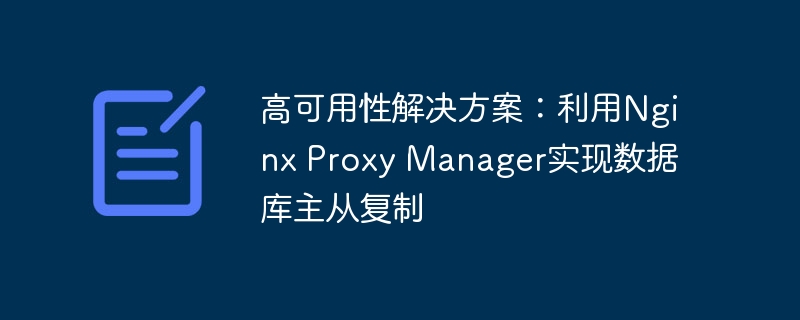

High availability solution: Using Nginx Proxy Manager to implement database master-slave replication
Introduction
High availability is a very important requirement in modern enterprises. In online applications, database plays a vital role. In order to ensure the integrity and reliability of the data, we need to take some measures to ensure the high availability of the database. This article will introduce a solution using Nginx Proxy Manager to implement database master-slave replication, and provide specific code examples.
[mysqld] log-bin = /var/log/mysql/mysql-bin.log server-id = 1
Then, restart the main database for the configuration to take effect.
First, we need to configure the replication parameters from the database. In the MySQL configuration file, set the following content:
[mysqld] server-id = 2 relay-log = /var/log/mysql/mysql-relay-bin.log log_slave_updates = 1 read_only = 1
Then, start the slave database and execute the following SQL statement:
CHANGE MASTER TO MASTER_HOST='主数据库IP地址', MASTER_USER='复制用户', MASTER_PASSWORD='复制用户密码', MASTER_LOG_FILE='mysql-bin.000001', MASTER_LOG_POS=107;
Note that the parameters in the above statement are replaced with your own parameters .
upstream db_servers {
server 主数据库IP地址;
server 从数据库IP地址 backup;
}
server {
listen 3306;
location / {
proxy_pass http://db_servers;
#下面是其他的Nginx配置
}
}Then, restart Nginx Proxy Manager to make the configuration take effect.
Conclusion
Through the above configuration, we successfully implemented master-slave replication of the database and used Nginx Proxy Manager to achieve high availability. This solution ensures fast database switching and data reliability in the event of a database failure. Hope this article helps you!
References:
[1] MySQL Documentation. Replication. [Link]
[2] Nginx Documentation. Proxying TCP and UDP Load Balancing. [Link]
The above is the detailed content of High availability solution: Using Nginx Proxy Manager to implement database master-slave replication. For more information, please follow other related articles on the PHP Chinese website!




